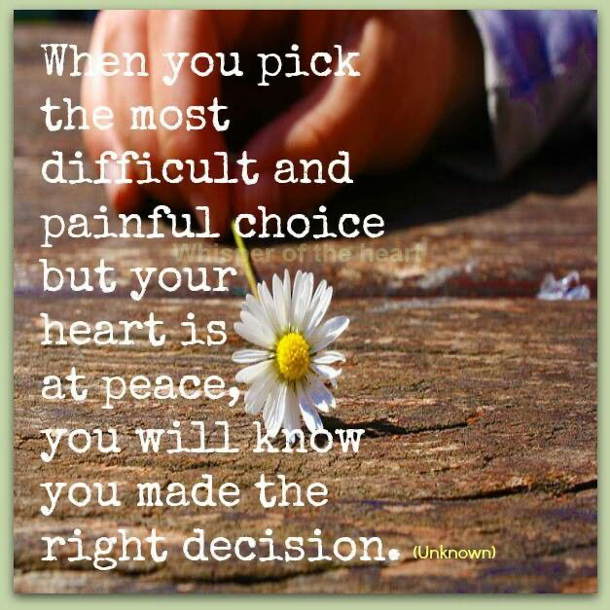It seems there isn’t a week that goes by that doesn’t demand we make decisions about our safety and health as well as that of our families’, elections, finances, how to better show respect for each other, and what to do about school for our children. While that is always the case in some way, 2020 has certainly brought all of these issues to a much higher frequency and intensity than we’ve had to deal with in the past. It’s hardly a surprise, then, that both anxiety and depression are rising at a very high speed and being predicted to be the next pandemic we’ll have to address. In fact, the Arizona Republic today reported that a warm line that is for those struggling with those feelings has gone from an average of 850 to 1500-2000 calls a week since mid-March. So, with an awareness of how much stress is on individuals with decisions right now and the anxiety and depression increase I’m including a Part 1 and Part 2 to this blog. The first is on decision making, and the second on anxiety and depression.
Part 1: Decision Making
Weighty decisions can be difficult to make when the options are clear or there are good arguments to be made for either side. And right now, that is proving especially true. It’s tough to know the right thing to do, isn’t it? Mask wearing. Elections. Going back to school or a workplace. How do you make decisions when there are so many unknowns, and the options are not the best? There was a clip on Good Morning America this past week from a pediatrician who was sharing her advice on making decisions. Her focus was on safety of students returning to school but my takeaway was something that could be expanded to broader decisions: there is no “right” decision. A person just has to make the best decision for his or her family with the information available at the time and move on. So, let’s take it back to the basics, and start with the decision-making process itself.
1. Identify the decision: Clearly define the nature of the decision you must make.
2. Gather relevant information: Collect some pertinent information from trusted sources. Some information is internal: you’ll seek it through a process of self-assessment. Other information is external: you’ll find it online, from other people, and from other sources.
3. Identify the alternatives: As you collect information, you will probably identify several possible paths of action, or alternatives. You can also use your imagination and additional information to construct new alternatives. In this step, you will list all possible and desirable alternatives.
4. Weigh the evidence: Draw on your information and emotions to imagine what it would be like if you carried out each of the alternatives to the end. As you go through this difficult internal process, you’ll begin to favor certain alternatives: those that seem to have a higher potential for reaching your goal.
5. Choose from alternatives: Once you have weighed all the evidence, you are ready to select the alternative that seems to be best one for you. You may even choose a combination of alternatives. Your choice in Step 5 may very likely be the same or similar to the alternative you placed at the top of your list at the end of Step 4.
6. Take action: You’re now ready to take some positive action by beginning to implement the alternative you chose in Step 5.
7. Review your decision & its consequences: In this final step, consider the results of your decision and evaluate whether or not it has resolved the need you identified. If the decision has not met the identified need, you may want to repeat certain steps of the process to make a new decision. For example, you might want to gather more detailed or somewhat different information or explore additional alternatives.
This process may be one you already intuitively use, but if you feel you’re more of a gut reaction person, write down the direction you want to take based on your instinct and then try using the process described above. Do you arrive at the same conclusion? Is there a way to blend both conclusions that feels like a well-informed answer for you? Remember that even in times of uncertainty, we can each only do our best. What is right for today may not be what is right for tomorrow, so take some time, consider all options, and trust yourself. We can only make the best decision for today, and with the information we have today. Know that and try not to question the decision later. Reassessing later is fine to see if you need to change direction, but it’s again a decision made from the information you have on that day. The decisions you make will be the right ones for yourselves for today, and that’s the best any of us can expect.
Part 2: Anxiety and Depression Increasing
Essentially depression is a feeling of hopelessness, sadness, and/or loss of interest in life or activities you would generally enjoy. It may be situational, i.e.: related to a current situation in your life; or, clinical, i.e.: related to a biological change or malfunction from medical, hormonal, genetic, or other reasons over which you may not have control. Anxiety is a sense of impending doom or reaction to a stressful or situations perceived as dangerous. The symptoms of each are specific, and you can get more information on anxiety and depression on our website.
Now that you understand it – what do you think? Are you suffering a bit from it? I do encourage you to track it for a while to see where you are with it and how it’s trending. So, get a piece of paper, a notepad in your device, or use a program, and rate it 1 (none at all) to 10 (you could act on suicide today). If it is 8-10 you need to call your doctor or therapist. Or, at the bottom are a few crisis lines if you can’t quickly reach someone for help. Please don’t let your ego or past beliefs get in your way – depression is a high-risk illness – and potentially can be fatal in a small number of cases. So, get the help you deserve. How about anxiety? I would encourage you to again track for a while – what is triggering it? If it’s decision making – see above. If it’s getting sick – work on focusing on what you’re already doing to take care of yourself and family. And if it’s always stuck in your head, ask for help.
If you are nervous about dealing with both children and work this fall, sit down and speak with your partner or a good friend and work out a plan for your day. Sometimes using a calendar helps one in organizing the day so you know what the children need to do and where they need to be – whether at school or online for school, work hours, doctor and other appointments, shopping, etc. And together also brainstorm all the free services or low-cost services you can call on to help save you time – Instant Cart, Door Dash, individual store shop and pick up options, and others. Also, who can you share with and split the errands or needs? Perhaps after reviewing your calendar together your spouse or partner can list all the errands for the week, and each agree to handle some of the work. The same with work around the house. Often an hour of planning can help save you hours. And that will mean decreased anxiety and depression.
Other anxiety and depression prompts can be larger with less tangible solutions. Things like, will I be laid off? How will I survive if that happens? What will happen in the election? Worry about a parent in an assisted care whom you cannot visit presently. Or even a lonely feeling of not seeing friends as you have in the past, the isolation many are enduring. Interestingly the steps are similar to decision making in that we need to first identify what is triggering the feeling. Next, look for information about that to identify whether you are worrying or anxious about a reality or something that isn’t real at present. An example might be a fear of being laid off as fear of the economy is in your mind. Well, check out your company’s financial condition, see what your boss or Human Resources know about potential lay-offs. They won’t give you concrete assurances, but often you can identify whether things have even been talked about and check the trade periodicals for the same. Then consider how to make your position and you more valuable to the company and be sure to improve your position through upgrading skills, identifying your successes to more than just yourself, and challenging any negative thoughts that are not grounded in facts. Even if you are affected by a lay-off by doing these last things you are upgrading your value to other companies. Then note this on your calendar for 30 days out and reassess. Each time you want to worry – take yourself back to the calendar and notice you have a “worry date” made for later. That written task let’s our brain let go of this more easily. The steps here are: a) identify the cause of the feelings; b) get information about the reality of the situation; c) determine if there is someone else who can help you gain more information or perspective (often this is a spouse or friend); d) list options you can take to better the situation for you; e) make a date to next evaluate the situation; and f) reassess it on that date.
Next time I’ll write about loneliness as it is impacting so very many individuals and I believe it is frequently underlying the current depression. But for now – you have some concrete tools to deal with situational depression and anxiety and decision making. I also have to encourage you to call on your spiritual resources, support people, creative outlets, and music. All can improve or worsen our current functioning. So, consider a step in each of these areas, you may be surprised how much something as simple as listening to music if you haven’t for awhile will help your mood. Or coloring a mandala. Or even just doing a walking meditation or online church service. We’re not made in isolation, folks, we need others to live successfully. So, use the creations of others (music), the connection spiritually that you have; the friends and close others in your life as well as family; and creation outdoors to bolster you at these times. And if it is even too much for those resources, see the resources for immediate help if you can’t reach a therapist or physician. But take care of yourself and reach a therapist or doctor for ongoing care.
To close I’ll share a prayer that was written during a time of great difficulty 100’s of years ago:
All shall be well.
And all shall be well.
And all manner of thing shall be well. (Julian of Norwich)
Be well and take care of yourself,
Dr. Beth
Teen Lifeline: (for teens) 602-248-8336 or 1-800-248-8336
Maricopa County Suicide and Crisis Hotline: 1-800-631-1314 or 602-222-9444
National Suicide Prevention Line: 1-800-273-8255 and for Spanish: 1-888-628-9454
Crisis Response Network: 602-347-1100
Decision making process excerpts taken from https://www.umassd.edu/fycm/decision-making/process/

















